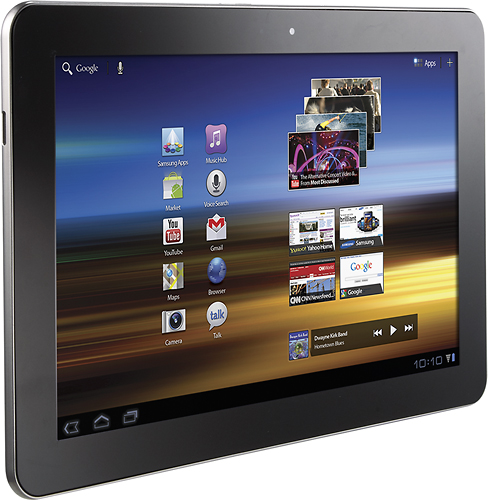Samsung Galaxy Tab 10.1: A Second-Gen Android Tablet
Samsung's Second-Generation Galaxy Tab
Do you want to win a Samsung Galaxy Tab 10.1 of your own? How about an Eee Pad Transformer, an Acer Iconia Tab A500, or a Lenovo IdeaPad K1? We're giving away all of those Nvidia Tegra 2-powered tablets and more (special thanks to the TegraZone team for providing the prizes)!
Read through our Eee Pad Transformer review and, on the last page, follow the link to fill out our entry form on SurveyGizmo. Good luck, Tom's Hardware readers!
Successful products are one part innovation and one part timing. Apple got both halves of the recipe just right with its iPad. Introduced in April 2010, the original iPad was a refreshing take on mobile computing that stripped away the familiar keyboard and incorporated a power-friendly hardware architecture. While the iPad wasn’t particularly slick or slim (compared to today's standards, at least), it benefited from being the first tablet. That's a massive advantage, especially when you take into consideration Apple's understanding that it needed huge developer support right out of the gate. And when tablet-curious buyers ask if a new contender is an iPad 2-killer, then it's clear which company is setting the standard.
Although Google's Android-based tablets are increasingly garnering accolades, it's hard to go head-to-head against Apple while playing a game of catch-up. The first Honeycomb-based tablet (Motorola's Xoom) debuted in early February 2011. That was almost a year after the iPad. Fortunately, Samsung’s Galaxy Tab 10.1 narrows the timetable significantly. It's the first second-generation Android-based tablet, and it follows Apple's second-gen offering by just a few months.
Tablets released prior to the Xoom didn't really compete in a meaningful way against Apple's solution. All of them, including Samsung's Galaxy Tab, used Gingerbread (Android 2.3), which Google intended for use on smartphones. Honeycomb (Android 3.0) is a completely different beast because it was created with tablets in mind.
But while Google offers a true tablet experience with its Android 3.0 operating system, it doesn't make its own tablets. Instead, it relies on hardware vendors that use its software on their own interpretations of what a tablet should be. And up until now, that hardware has come across as less refined than what Apple offers. That’s not completely fair, though. Tablets like the Xoom, Iconia A500, and Eee Pad Transformer represent first-generation Android-based tablets, which is why they're more accurately compared to the original iPad.
Plenty of time has passed, though, and the hardware is finally catching up to the software. Samsung has the first second-generation Honeycomb-based tablet in its Galaxy Tab 10.1, and it's one of the best mobile devices we've seen thus far (and that's even compared to the iPad 2). What makes this implementation different? How did Samsung turn thing around? We're putting this tablet through our usual gauntlet of poking and prodding, bringing you the answers.
Get Tom's Hardware's best news and in-depth reviews, straight to your inbox.
Current page: Samsung's Second-Generation Galaxy Tab
Next Page Meet Samsung's Galaxy Tab 10.1-
killerclick No surprises here, iPad 2 is still on top, being the engineering masterpiece that it is. Take a look at side-by-side comparisons of iPad 2 and Galaxy Tab 10.1 on YouTube and you'll see how much smoother animations and video recording are on the iPad 2.Reply -
Martell77 I'm going to be in the market to buy about 150 tablets soon and from this article it appears that the ASUS 3.2 is the best all around for price/performance/recharge. While it doesn't win alot, it appears to be a consistant performer and has a relativly short recharge time.Reply
Or am I missing something here? -
dthx The reason why Samsung doesn't want to lower it's price is easy to understand: there are many (stupid) persons who are convinced that the iPad is superior to any other tablet just because it's priced higher... Samsung wants to make sure they capture that part of the market.Reply
But the author is right: if there is one reason Apple should sue Samsung, it's for copying the price structure of the iPad! -
Haserath Samsung Galaxy Tab needs a split keyboard feature in portrait mode; it isn't comfortable enough to have to stretch to hit the virtual keys.Reply
The 10.1 is still too slow for certain browsing. Flash is good as long as you don't want to rewind or fast forward through it. It sometimes slows down when I try typing also.
Since Apple produces both hardware and software, they can optimize their OS for the exact hardware they put out.
After trying the Samsung Galaxy Tab 10.1, I would say it's just a little too immature still. A good year or two and tablets will be perfect for browsing, gaming, and some other tasks while also being lightweight and easy to use even compared to laptops. -
Hmmm, many talk about iPad dominance but don't know all the facts. Just looking at a device in the store doesn't cut it folks. Android tablets are going to start cutting into market share, like it or not. For an IT person or true techie, most would choose an Android tablet. 4 core coming soon and they are going to rock the scene. Example: my Acer Iconia costs quite a bit less than iPad2.Reply
-Full USB port for mouse, keyboard, portable hard disks/thumb drives, cameras
-Overclocked and stable dual core CPU @ 1.504 Ghz (big change in performance)
-Customizable and open operating system (and it's going to get better with ICS)
-Honeycomb 3.2
-Netflix and Hulu working
-Mount drives from Linux, Windows, and OSX
-Websites with Flash that look the same as on a PC browser (now theres a concept)
-Wide screen 16:9
-5MP rear camera + front facing camera.
-HDMI out
-Charges back up in 1hr
-
dennisburke Price, proprietary cable management, and lack of expandable storage all lead me to want to wait to see what happens after Windows 8 becomes available.Reply

